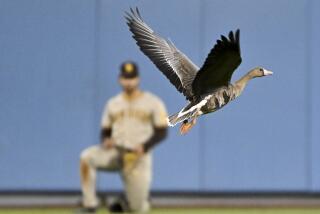Gopher Getter : ‘G-Man’ Kills 2,000 for City of Torrance
- Share via
They call him the G-Man.
Gophers are his game.
Hank Baranowski’s hunting ground is a 53-acre park in Torrance, where hundreds of gopher burrows used to make it difficult or impossible to use playing fields.
“He is renowned in our department for his ability to wipe out gopher populations,” said Gene Barnett, director of parks and recreation for Torrance.
Over the years, about 2,000 of the wily rodents have met their match in Baranowski, who savors his reputation as the city’s premier gopher grabber.
Skulls Mounted in Cart
In fact, until an aghast superior put a stop to it, Baranowski used to drive his city golf cart around with two gopher skulls mounted behind the seat.
He pleaded for care in telling his story.
“You’ll have every environmental group coming after me, (saying) ‘Save the gopher!’,” he said.
“It’s part of my job, that’s all. . . . They are destructive. It’s a shame, because they are nice little things. So furry.”
Michael Dee, curator of mammals at the Los Angeles Zoo, said gophers “were here before we were. What has happened is that man has gone into their territory.”
In an interview, Dee acknowledged that gophers tear up playing fields to the point of making it difficult to use them, but added, “If it were me . . . I would try to co-exist with them.”
Not Baranowski.
This gopher nemesis is relentless. He grabs their tails. He comes after them with two types of traps. He flushes them out with water.
Bitten 3 Times
“I really am good at it,” he said. He has been bitten only three times.
By his own count, Baranowski got 652 gophers on the City Hall grounds before being assigned several years ago to maintenance at Columbia Park, which is near 190th Street and Prairie Avenue.
At Columbia, a grassy expanse with six soccer fields and two baseball diamonds, he has trapped 1,573 gophers in what amounts to continuing underground warfare.
The biggest was a female he caught Dec. 27, 1984. She weighed 2 pounds, 1 ounce. “She might have been pregnant,” he said.
On his biggest day, about two years ago, he and another employee caught 19 gophers. “Nobody beat that,” he said.
With mock reluctance, he declined at first to talk about his methods. Then, in a heavy Brooklyn accent, he said: “I can’t go out and tell my secrets. No more job security. They’ll get some young guy to do this.”
Actually, he said, catching gophers isn’t so difficult. He said he knew nothing about gophers when he began trapping them seven years ago.
Kicking Up the Dirt
As a groundskeeper at City Hall, it was his job every day to level the dirt that the industrious gophers had kicked up the night before.
“I got tired of clearing their mounds. I got very annoyed,” he said. “They can’t cut the grass and it looked like hell.”
He went to his boss and said:
“This is stupid. Let’s eliminate the gophers.”
He got the go-ahead and went to the Torrance library. Practically everything he learned there, he said, was wrong.
A library book said gophers come two to a litter. But he has found as many as six gopher babies at a time. “It said they only burrow to six to eight inches,” he said. “We found that they go down to a foot.
“I started going after them. I learned my own ways of doing things.”
Although many recommend wearing gloves when handling gopher traps to eliminate the human scent, Baranowski found the gophers didn’t notice. And the standard advice is to wash the traps after a kill.
“That’s a lot of bull. I use the same trap two and three times a day,” he said.
Killed Instantly
He usually digs out a plug of dirt midway between two gopher holes, planting a trap in a connecting tunnel. The traps, which work somewhat like mousetraps, usually kill the gopher instantly.
If the burrow is in clay soil, Baranowski will stick a garden hose down the gopher hole and try to flood it out. After awhile, if the water runs the right way, a half-drowned gopher will struggle out through one of the mounds.
“Once they are wet, they can’t run for beans. I pick them up by the tail,” he said.
Baranowski has tried several methods of disposal.
Once someone suggested he skin the gophers and “make a Davy Crockett cap. I said, ‘God, I’d have one for everyone in the city.’ ”
For a while, he went to the Madrona Marsh, heaving the bodies of the dead ones over the fence and liberating the ones captured live. The idea was to help feed foxes and hawks.
Natural Balance Disturbed
But the Friends of Madrona Marsh, an environmental group, protested that Baranowski was altering the natural ecological balance. Barnett asked him to stop several months ago.
Until six months ago, Baranowski’s way of disposing of the live ones occasionally smacked of a blood sport. He used to set the gophers free on a baseball infield near the east side of the park.
An exceptionally large hawk, perching on the top of the 494-foot KNX antenna located in the park, would swoop down and snatch the hapless gopher frantically trying to dig through the hard-packed dirt. The hawk would fly back to the top of the antenna and eat the gopher.
Other parks employees “got a big kick out of it,” Baranowski said. They were always asking, ‘Hey, Baran, you got any live gophers?’ ”
About six months ago, the hawk flew away. Now, Baranowski says, he drowns live gophers and puts the bodies in the garbage.
Besides the hawk, other natural predators catch gophers in the park.
One black cat, in particular, “is a genius,” Baranowski said with the admiration of one good hunter for another. “He has very good patience. He lays there, then, swat! With one paw!”
A gopher stuck a brown, bewhiskered face above a small mound of dirt and peered inquisitively, if nearsightedly, at the enemy, then vanished into his hole.
Baranowski moved in with a running garden hose.
He stuck the hose into the rodent’s hole and waited for a gopher to emerge. The water gurgled into the ground for more than 20 minutes.
No gopher.
The next day, he inspected the burrow. Fresh dirt indicated the animal had survived the flood.
Baranowski put a trap in the burrow.
More to Read
Sign up for Essential California
The most important California stories and recommendations in your inbox every morning.
You may occasionally receive promotional content from the Los Angeles Times.










